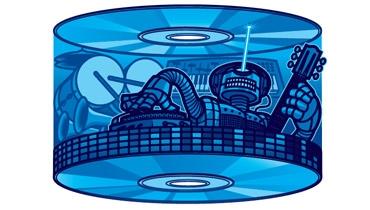Music's Ray of Hope

Congratulations! Way to go! You, the consumer, picked Blu-ray Disc over HD DVD as the high-def disc format of the future. And now, instead of two formats, we have one. Like it (those with cool, futuristic Blu-ray gear) or not (those with obsolete HD DVD junk), Blu-ray is the new world standard.
Videophiles can pop their corks and celebrate. With the format war over, they can now expect rapid rollouts of Blu-ray players from all the major manufacturers, as well as stepped-up Hollywood release dates. Blu-ray provides superb picture quality that will even challenge 1080p video displays, and it will pave the way for future display formats such as 4K, which more than doubles the resolution of 1080p. Like steak sauce poured over a sirloin, Blu-ray sweetens the already-delicious picture quality of upconverted DVD and makes it even tastier.
The videophiles' new HD video format makes audiophiles and their stinky downloaded music look shoddy. It's been a long time coming - from VHS to Blu-ray - but finally, video rules! Take that, you MP3 weenies! In a world of apparently backward-moving audio quality, Blu-ray propels video quality forward. Right?
Well, not exactly. Let's consider the assumption that Blu-ray is mainly about video. Sure, it's the successor to the DVD-Video format, but it could also be the successor to DVD-Audio and SACD. The DVD was meant to push the envelope in both video and audio quality. And SACD was designed to be a "super" CD. Alas, DVD-Audio never achieved even a fraction of its brother's success and, along with SACD, is dying out.
But all is not lost, because Blu-ray offers tantalizing opportunities for high-quality audio. Players are required to support Dolby Digital, DTS, and linear PCM decoding. Dolby Digital and DTS provide lossy 5.1-channel audio that's more than adequate for good sound quality. But PCM accommodates up to 8 full-range channels of uncompressed audio - more than enough for truly kick-ass multichannel recordings.
Moreover, players may optionally support Dolby Digital Plus and DTS-HD High Resolution Audio (up to 7.1 channels) as well as Dolby TrueHD and DTS-HD Master Audio (up to 8 channels). Significantly, while the first two formats are lossy, TrueHD and Master Audio provide lossless multichannel audio coding while minimizing bandwidth and data-rate requirements. Specifically, they can losslessly code 8 discrete audio channels at 24-bit resolution and 96-kHz sampling frequency, or 6 channels at 24/192. Blu-ray even has a spec dedicated to high-end audio playback, BD-Audio Profile 3.0 - a spiritual descendant of the DVD-Audio spec.
| Update: At least one label has seen the (Blu) light. Surround Records has released a Blu-ray Disc audio recording of Grieg's Piano Concerto and other works. Originally issued in 5.1, the title now has a 7.1-channel DTS-HD Master Audio mix with 24-bit/96k specs. Other 7.1 Blu-ray releases from Surround Records will include Tchaikovsky piano concertos and a sound-design work titled Africa. Meanwhile, noted digital-audio hater Neil Young has announced he will release his entire Archives series on Blu-ray. Well, it's a start . . . |
In other words, Blu-ray could unite the video and audio markets. Imagine buying music or a movie with the assurance that it will play in your Blu-ray player. Just as the CD established universally good audio, Blu-ray could become a "Blu CD" with better audio. Record labels, here's your chance to reconstitute the CD's brilliant success with a superior audio product.
For any labels interested in picking up where SACD and DVD-Audio left off, here are some tips. There's a sizable market waiting for audiophile Blu-ray content, in both stereo and multichannel 24/96+ audio. But if "special" players are needed to listen to audiophile Blu-ray Discs, the venture will fail. PCM files offer the greatest compatibility and should be used if bandwidth or bit rate isn't a constraint. If TrueHD or Master Audio coding are needed, then Blu-ray music discs should contain dual files so the disc can be played on all Blu-ray players. Operation must be simple; optional menus are okay, but music discs should start playing when loaded, and you shouldn't need a TV to listen to them.
Sure, there are lots of obstacles. We all know how multichannel-PCM DVD-Audio discs fared, even the ones with compatible Dolby Digital or DTS tracks. But that was in the context of the war with SACD. Blu-ray stands alone, and it offers a second chance. We can make Blu-ray sound as good as it looks. And if BD-Audio doesn't catch on, then I guess we audiophiles deserve our stinking MP3 files.
- Log in or register to post comments



































































